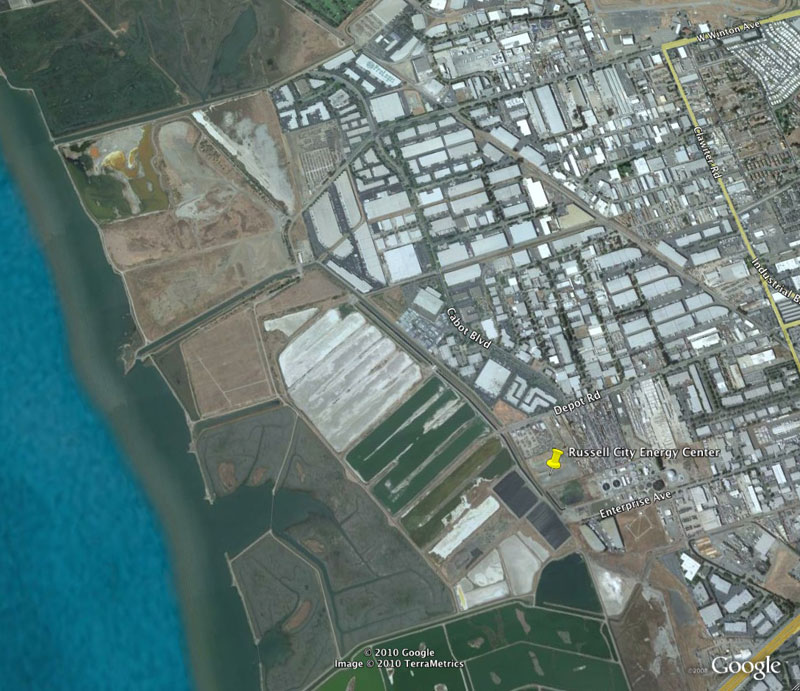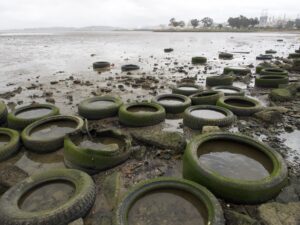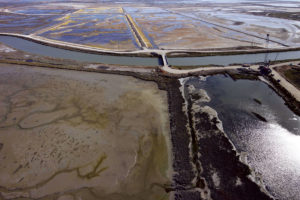Ernie Pacheco, co-founder of Citizens Against Pollution (CAP), steps out of his tiny blue hybrid Honda Insight and walks over to the Hayward Regional Shoreline. An egret and heron fly past. Pacheco has spent years working in construction in this area, so the tall, tanned nature-lover knows the shoreline well. On evenings and weekends, he religiously jogs the five-mile loop along the Bay Trail here.
But that’s not what brought him to the shoreline today. Pacheco has been fighting a proposal by Houston-based energy company Calpine to build a 600-megawatt natural gas power plant near here. In February, Calpine’s Russell City Energy Center received permit approval from the Bay Area Air Quality Management District (BAAQMD), almost nine years since the original application. The plant’s design has gotten some plaudits for a first-of-its-kind cap on carbon dioxide emissions, but critics are worried that the plant, which will be the region’s seventh-largest single source of air pollution, will have significant impacts on local wildlife and people.
“It’s a full-time job fighting this thing, but I do it to protect the environment and the critters on the shoreline,” says Pacheco, whose local group is part of a large coalition that includes the Sierra Club, Earthjustice, the California Native Plant Society, GreenAction, the Hayward Area Planning Association, and other local and regional organizations. Now, opponents are gearing up for a March 22 deadline to appeal that permit.
Wildlife Impacts?
Here in a section of Hayward that mixes industry and bayshore habitat, wildlife impacts are at the top of the list for project opponents.
“The power plant site is within a stone’s throw from the shoreline marsh and right next door to (wastewater treatment) ponds, all actively used by waterfowl,” says Laura Baker, with the California Native Plants Society’s East Bay chapter. “One of the major points we’ve made is that when you put something as huge as the seventh largest point source for pollution in the Bay Area, with millions of tons of pollutants a year, in close proximity to wildlife, we need to do a detailed analysis.”
Baker is concerned that regulatory agencies haven’t done that analysis, so there is no clear understanding of what the power plant will do to nearby endangered species such as the salt marsh harvest mouse, the California clapper rail, and the California least terns, all of which have been subjects of significant local management and restoration efforts over the past decade.
On January 25, 2010, the U.S. Fish and Wildlife Service published a letter concluding that the proposed energy center is “not likely to adversely affect any federally listed species under the administration of the Service.” That helped smooth the way for the regional air quality district’s approval in February.
Fish and Wildlife representatives Al Donner and Jim Browning explain that they performed a two-pronged analysis as part of their informal consultation.
“The first thing we look at is habitat and any direct effects to habitat,” says Browning. “When you look at the location and ancillary sites, you can clearly see that there is no natural habitat on the site. That’s the bottom line.” Browning says that he did not personally go to the site, but that “an analysis using Google Earth makes it clear that it is a heavily disturbed area with no native terrain or habitat. There was no real need to actually look at the site.”
Wildlife officials also considered “indirect effects and adjacent habitats.” Donner says agency staff “did this in the most conservative manner and used the ‘minimal distance,’ which is the nearest point of the project to the edge of the nearest habitat site.” The closest endangered species are the salt marsh harvest mouse and the California clapper rail, whose habitats sit approximately 1,300 feet away. The next listed species is the California least tern, whose habitat is a small island 3,400 feet away. “These distances are pretty great,” says Browning. “This project is designed in such a way that from our standpoint it shouldn’t cause any impacts.”
The service will continue oversight on Calpine’s noise, lighting, and liquid discharge plans and must approve of the plans before Calpine can move forward with construction. “We want to take an abundance of caution,” says Donner, “but we’re not in the business of enforcement. We rely on the East Bay Regional Park District and landowners in the area if they have concerns.”
Arthur Feinstein, conservation coordinator at the Citizens Committee to Complete the Refuge and former conservation director at the Golden Gate Audubon Society, says the Fish and Wildlife Service has the discretion to perform wildlife impact analysis in whatever way they deem proper. But he says the most cautious approach would be to look at wildlife in the area over a longer period of time. “You have to go out and look over a period of time in different seasons. If you look in the summer, you’re not going to see shorebirds or ducks, for example.” Feinstein did this very type of two-year survey to assess seal habitat near San Francisco’s Hunters Point power plant, which was shut down in 2006 after decades of community pressure. “We were there every other weekend for a year, at low tides and high tides, in different conditions. That’s what it would take.”
The View from the East Bay Regional Park District
Larry Tong, interagency planning manager for the East Bay Regional Park District (EBRPD), which manages the Hayward Shoreline, says the district was concerned in 2001 with Calpine’s original site, which sat directly on seasonal wetlands. At the time, the district was negotiating with Calpine to secure a formal agreement “including donation of land and sizeable endowments for operating resources” to manage the affected wildlife habitat.
Calpine later decided to move the project to its current site, farther away from the shoreline. “At this point, with the new location, we can’t say definitely that there will be impacts to the park district’s resources.” Tong says the district is unlikely to appeal the permit, but it is in negotiations to obtain a revised agreement for the new location. EBRPD Land Acquisition Manager Nancy Wenninger says, “Negotiations are on-going with Calpine and the City of Hayward to find some acceptable middle ground that serves the public.”
Impacts to Soil & Vegetation?
Given the power plant’s emissions of air pollutants such as carbon monoxide, nitrogen oxide, sulfur dioxide, particulates (soot), and other potent toxins such as benzene and toluene, some activists are worried that it will have impacts even on fairly distant sensitive habitats, particularly that nitrogen deposition will affect the rare serpentine prairie in the Oakland hills in Redwood Regional Park, an area undergoing major restoration because it’s one of only two habitats for the Presidio clarkia, an endangered wildflower.
As nitrogen is emitted from the power plant’s stacks, it may get deposited into area soils, essentially providing unnatural fertilizer. In serpentine prairie, if too much nitrogen gets added to the soil, native plants adapted to nitrogen-poor soils can get pushed out by invasive exotic annual grasses.
Laura Baker of the California Native Plant Society raised this concern during the public comment period of the permit review. In particular, Baker says the air quality district’s computer modeling was improperly done. “Their bio monitoring was sloppy and they used inappropriate vegetation communities in the model. Though the area is grassland, they modeled it as forest,” She says. “We should put a precautionary principle into play and do it right.”
In its February 2010 response to public comment, the air quality district said, “The characterization of the habitat as forest rather than grassland actually resulted in a conservative over-estimation of potential deposition in those areas,” and “computer modeling is a well-accepted method for determining what ambient air quality concentrations could result.”
A Potential Solution?
Scientist Stuart Weiss, with the Creekside Center for Earth Observation, is probably the region’s foremost expert on nitrogen deposition’s effect on ecosystems, and he has a lot of experience analyzing the impacts of power plants. In 2006, he wrote a report for the California Energy Commission entitled Impacts of Nitrogen Deposition on California Ecosystems and Biodiversity.
“What you have is this point source that’s contributing to what’s already a major plume source of that area,” he says. “The effects of that single project are dispersed across a broad area and at some point it gets lost in the overall urban plume.”
However, he says there are documented effects of power plants to serpentine grasslands. “We should be funding things like weed management areas dealing with the general impact of nitrogen deposition and emission,” he says. Instead of worrying about detailed impact analysis for one project, Weiss recommends setting aside “money to manage landscapes.”
“We already have a model for getting something out of this,” Weiss says, referring to the three energy plants – Santa Clara’s Silicon Valley Power and San Jose’s Metcalf Energy Center and Los Esteros Critical Energy Facility – where money was set aside by the energy companies for long-term habitat management. Such endowments covered land purchases, operating resources, habitat monitoring, and overall management plan execution.
Next Steps
As the park district continues negotiations with Calpine and the City of Hayward for a habitat management plan similar to the one Weiss recommends, the permit appeals process continues. Monday, March 22, 2010, is the deadline to appeal the Russell City Energy Center permit with the EPA Appeals Board.
Ernie Pacheco and the Citizens Against Pollution are filing an appeal along with other organizations. “We need biologists, naturalists, and others to comment on wildlife impacts, soil and vegetation impacts, and in management of sound, light, and liquid discharge,” says Pacheco who urges interested individuals to contact him at CAP, Citizens Against Pollution, (510) 785-2840.
“We would love to talk to anyone who wants to contribute.” But time is running out, and appeals must happen this week. Pacheco says that the only other appeal option after this would be to take it up with the California Energy Commission, “though it’s unclear whether we will get this chance.”
Permit information can be found here.
Information on how to file a Petition for Review can be obtained at (202) 233-0122 or at epa.gov/eab.
To reach the CEC, contact Mary Dyas, Project Compliance Coordinator, Siting, Transportation and Environmental Protection Division, 1516 Ninth Street, Sacramento, CA 95814. Phone 916-651-8891. E-Mail: MDyas@energy.state.ca.us.

.jpg)




